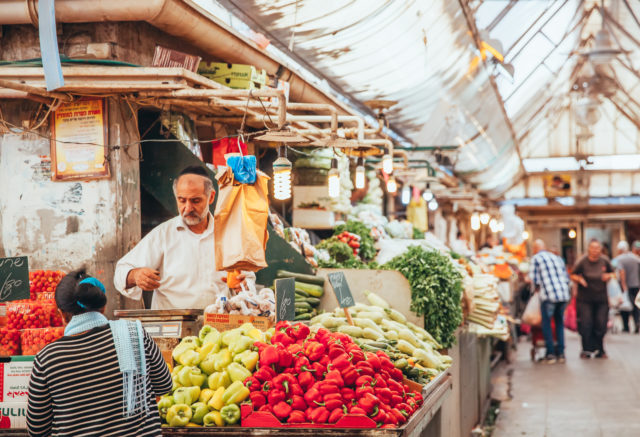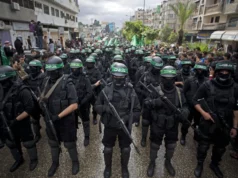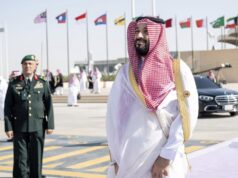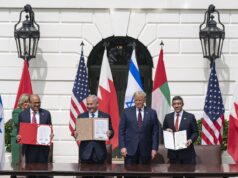The struggle for sovereignty in Jerusalem has transitioned from the “Jerusalem of Above” – in the sense of the political summits of Oslo and Annapolis – to the “Jerusalem of Below,” in the sense of daily life in the city. The real limits to control and sovereignty are not determined in clandestine talks between unnamed high-ranking officials, but rather by demarcating areas of activity for the municipal street cleaner, the youth counselor at the local community center, the building inspector, road engineer, policeman and social worker, who provide services for the residents and are clearly identified with Israeli institutions. Governance and sovereign rule in eastern Jerusalem requires a quantum leap in the level of services provided by Israel, alongside effective community policing efforts.
The Arabs of eastern Jerusalem are caught in a vortex of emotions and mixed feelings of despair and hope, fatigue and vigor, envy and pride, dream and reality. The contrast between the strong national and religious symbolism that Jerusalem (or al-Quds, in Arabic) holds for its Arab residents on the one hand, and their accelerated integration into Israeli society, both in the city and elsewhere, on the other has entangled them in a thicket of contradictions.
Among them: Palestinian national identity alongside an unprecedented demand for Israeli citizenship; stone throwing at Hadassah Hospital on Mount Scopus but valuing the care Arabs receive there; protesting the enforcement of planning and building laws in Arab neighborhoods while calling for an increased police presence there to maintain public order; campaigning against “normalization” with Israel in tandem with a tremendous interest in learning Hebrew and an increasing preference for an Israeli rather than Palestinian matriculation certificate; flying the flag of Palestine and spray-painting nationalist slogans in praise of Fatah on the walls of buildings while expressing vicious criticism of the head of the Palestinian Authority (PA), Mahmoud Abbas, on social networks.
And, alongside the growing power of conservative Islamist forces in the public domain, there is also greater sexual permissiveness in the private domain and a growing laxness in the observance of family values and tradition.
In this sense, eastern Jerusalem Arabs are at an historical crossroads, no longer able to straddle the fence between the PA and Israel, bringing to a head a decision between the alternative senses of belonging.
Eastern Jerusalem: Context
“Eastern Jerusalem” is the term applied to the neighborhoods within the municipal jurisdiction of Jerusalem beyond the 1949 armistice line (also known as the Green Line or the pre-1967 line). The term is somewhat inaccurate from a geographical perspective since it also includes territory north and south of the city.
These neighborhoods cover about 70 square kilometers. In fact, the area of pre-1967 Jordanian Jerusalem was only 6.4 sq. km., in the Old City and its immediate environs. After the 1967 Six Day War, Israel annexed an additional 63.6 sq. km., consisting mainly of 28 Arab villages. The Arab population of the newly united Jerusalem in 1967 was about 70,000 (alongside 197,000 Jews), constituting 26.5% of the city’s population.
Residents of eastern Jerusalem have the legal status of “permanent residents,” which in practice is the same as that of foreign nationals who reside in Israel. The Arabs have the right to live and work in Israel (unlike Palestinians of Judea and Samaria). They also have benefits under the National Insurance Law and the National Health Insurance Law. As permanent residents, they are eligible to vote in municipal but not national elections. If they leave the country for more than seven years they risk losing this status.
Research studies and public opinion surveys reveal that safeguarding their permanent resident status and remaining eligible for national insurance benefits and healthcare, rank high among the reasons for the Palestinians’ preference for living within the municipal boundaries of Jerusalem, even though they could probably find cheaper and better housing elsewhere.
Permanent residents can apply for full Israeli naturalization, which requires them to swear allegiance to the state, submit proof that they do not hold any other citizenship (many residents of eastern Jerusalem hold Jordanian citizenship), and demonstrate some fluency in Hebrew.
Thousands of eastern Jerusalem Arabs apply for the permanent status of “citizen” in place of their temporary “resident” status. But the slow process, owing to the lack of qualified officials in Israel’s Population Authority, makes them ponder why such a core identity step on their part is met by such a weak Israeli response.
Permanent residents currently number some 320,000 (plus about 50,000 illegal Arab residents), constituting about 37 percent of the city’s population and 20 percent of the Arabs within Israel’s borders. Jerusalem is home to the largest concentration of Palestinian Arabs between the Jordan River and the Mediterranean (excluding Gaza). By comparison, the population of Ramallah is about 280,000 and of Nazareth, the largest Arab town in Israel, 75,000. Regarding religion, the majority are Muslims, with only a small minority of Christians (10,000-15,000).
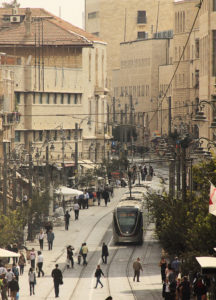
About 120,000 eastern Jerusalem Arabs live in neighborhoods that lie within the municipal boundaries of the city but are on the other side of the security fence (constructed around Jerusalem between 2002 and 2007). These neighborhoods are marked by severe overcrowding and extensive illegal construction to a much greater extent than the neighborhoods inside the fence.
The fence has cut off the Jerusalem Arabs who live within it from Ramallah and the West Bank, and intensified their links to the employment, welfare, healthcare, and economic infrastructure of western Jerusalem, and consequently to the city’s Jewish sector.
“Rejected Child” Matures
The Arabs of eastern Jerusalem feel trapped between Israel and the PA. They are the “rejected child” of “warring parents,” Palestinian and Israeli, each of whom is devoted to their other, “preferred” children.
After 50 years of transience, the “rejected child” is at the height of adolescence and wishes to challenge his parents. This process has generated on the eastern Jerusalem street an intense desire for “permanence,” which is at the heart of sharpening power struggles between pro-Palestinian elements and those seeking to realize their rights as equal residents vis-à-vis the Israeli authorities. These inter-communal struggles include physical violence, threats, and intimidation, especially by supporters of the Palestinian side.
Eastern Jerusalem Palestinian youth are torn between a growing number of colleges providing Hebrew classes and advanced professional training, and Fatah sports and cultural clubs with a revived budget by the PA.
There is a struggle between parents’ committees that support the introduction of the Israeli curriculum for schools in eastern Jerusalem with the aim of broadening their children’s educational and professional horizons, and parents’ committees affiliated with the PA who wish to preserve the Palestinian curriculum due to its national characteristics even though its benefits for access to higher education and better employment are low.
To further complicate matters, the Israeli government appears not to have decided whether it wishes to view this community as an integral part of Israeli society or as residual leftovers.
In recent years, the Jerusalem municipality has undertaken a major effort to reduce disparities in the eastern part of the city and increase enforcement and governance levels, in coordination with and with the assistance of the district police. The government also recently passed two resolutions allocating a large-scale budget for eastern Jerusalem, some of which is already being realized, to the benefit of the residents.
However, for a significant improvement in the poor standard of living in most eastern Jerusalem neighborhoods, a vast investment of billions of shekels is needed in all areas of life, particularly infrastructure. It seems that the State of Israel has yet to realize that the struggle for control and sovereignty in Jerusalem, which was conducted in the past by high-level international summits and closed forums, is now managed on the ground.
Terror and Incitement
Terrorist attacks and the wave of stabbing incidents led by eastern Jerusalem Arabs also express, in their own mind, an attempt to delineate the borders of the “Palestinian territory” in Jerusalem with blood and terror. Internal discourse among Jerusalem Palestinian youth on the social networks – alongside the glorification of “shahids” defending al-Aqsa mosque – includes political discourse emphasizing that deterring the Jews from reaching the city’s “seam lines” between east and west also demarcates the Palestinian area of Jerusalem.
The intense effort on the ground over the past year to move on from the intermediate status has created a sense of urgency on the governmental side, both Palestinian and Israeli, to take a clear stand on governmental investment in eastern Jerusalem and upgrading the level of on-site enforcement and policing. In response, the Israel Police announced a new security concept that advocates enhanced police presence in eastern Jerusalem and establishing integrated policing centers – which will provide both policing and civilian community services to these neighborhoods.
The past year has also seen a marked trend in the PA boosting its dimensions of sovereignty in the city. A reflection of this is the Palestinian government’s budgetary plan of a total of NIS 25 million (of which it is unclear how much, if any, will materialize) for eastern Jerusalem.
This includes enhancement of the symbolism of building and renovating houses in Jerusalem by the PA (in the Palestinian narrative, Israel demolishes Arab homes in Jerusalem); a focus on the Old City in an effort to prevent “Judaization”; encouraging the establishment of sovereignty symbols competing with Israel’s, such as Palestinian hospitals and emergency medical services; and encouraging Palestinian higher education over Israeli.
Alongside the political struggle, the struggle over the Temple Mount (“Haram al-Sharif” in Arabic) has become more acute. The “metal detector crisis” reflects an almost-exact realization of this author’s assessment from the spring of 2017 regarding the strengthening of the Muslim Brotherhood axis at the expense of the PA axis in the Palestinian arena in general and in eastern Jerusalem in particular.
Social media pages affiliated with the Islamic Movement showcased their blatantly inflammatory incitement against the metal detectors, while in the Palestinian news agencies identified with Abbas this issue was marginalized.
But events unified all the various streams and segments of the population and consolidated the sense of internal unity, which was severely impaired in recent years by the Hamas-Fatah conflict and the geographic separation (Gaza – Judea and Samaria). As the events on the Temple Mount subsided, the Palestinians of eastern Jerusalem felt a sense of victory that was probably their first in 50 years of Israeli rule.
Moreover, in the eyes of the Palestinians, a new worldview was forged in the Palestinian struggle against the Israeli regime, namely, civil resistance (mass prayer in the streets as an example), which led to more significant achievements than those of violent resistance.
Developments reflect the entry of the Jerusalem Arabs into the power parallelogram operating in the city. The Temple Mount is no longer a sacred site for which decisions are shaped by the Hashemite Kingdom of Jordan and Waqf officials, but a site on which the Arabs of Jerusalem can have significant influence.
The Intermediate Situation
Against the backdrop of the political stalemate, the components of real sovereignty will be dictated by actions on the ground (bottom-up) rather than by top-down planning. Local factors are shaping a political reality rather than a political rationale shaping the situation – as would have been expected to occur in such a central and sensitive place.
If Israel wants to secure its sovereignty in Jerusalem, it must implement a widespread plan to boost its governance in the eastern part of the city by providing services and efficient enforcement and policing. “Soft” governance, which is expressed in the provision of civil services, does not relate only to the world of distributive justice and equalization of living conditions between the different parts of the city, but is related to the very core of the political experience of the Israeli-Palestinian conflict.
Anyone wishing to affect the nature of this conflict at its Jerusalemite core and the reality of coexistence between Arabs and Jews in Israel, will no longer be able to marginalize the issue of the civic engagement of eastern Jerusalem Palestinians.
In recent years there has been significant progress in realizing this obligation (especially by establishing schools and developing road infrastructure), but there is still a long way to go.
Islamic and Foreign Actors
Other important players are the Islamic organizations and some international actors. Consider Turkey’s efforts to expand its circles of control in eastern Jerusalem.
Turkey is injecting tens of millions of dollars in the areas of culture, welfare, education, and sports in eastern Jerusalem, while attempting to establish its status as guardian of eastern Jerusalem Palestinians against the “Judaization” of the city. The EU and UN auxiliary bodies also finance several projects in the areas of education, welfare, infrastructure, and so on, on a broader scale and at a higher level of visibility than in the past.
The increased foreign presence in the heart of Israel’s capital touches the deepest chords of the issue of Israeli sovereignty in the eastern part of the city. Those who believe that Israel should not impose its sovereignty on eastern Jerusalem might welcome this foreign presence. However, they must also take into account the security implications of the murderous anti-Jewish ideology that some agents of this presence are instilling in the 320,000 Palestinians who live alongside 550,000 Jews.
On the other side, those who condemn the foreign presence because it undermines Israeli sovereignty and/or due to its grave security implications must be aware that attempts to eliminate this presence, whether through security or diplomatic channels, are not enough. Some of these foreign organizations provide services required by the residents; their expulsion would require Israel to fill the void, and this would have major budgetary repercussions.
Israeli Policy Alternatives
Two plans for partition of the city have been floated recently.
The first, which enjoys the support of various Palestinian elements, would create a municipal separation including the establishment of a Palestinian municipality to manage the affairs of the Arab neighborhoods, but would not create a physical barrier between the two parts of the city. A joint committee or agency would coordinate between the two city halls, in conjunction with Israel and the Palestinian Authority.
A look at the map of the city makes plain that the Arab and Jewish neighborhoods are interlocked and sometimes only a few meters apart and some neighborhoods have a mixed population of Jews and Arabs. Daily interchange between the two groups has been facilitated by the road and public transportation networks that link Arab and Jewish neighborhoods.
The strongest opposition to the first proposal will be voiced by the Palestinian residents themselves. They view the PA as a corrupt and failed regime that has no commitment to provide decent services to citizens. Hence implementation of this plan might lead to an outflow of Palestinians to the Jewish neighborhoods that come under the jurisdiction of the Jewish municipality.
A 2011 survey polled eastern Jerusalem residents, posing the following question to its participants: “Should your neighborhood become subject to Palestinian sovereignty, would you choose to move to another neighborhood in Jerusalem or another city in Israel?” Around 40 percent of the responses were positive.
Additionally, it is predictable that in the case of Jerusalem, significant difficulties would arise in coordinating the municipalities where the shared life is at such intense and close levels. The municipal separation plan will also raise many difficulties in dealing with emergency and security issues in the delicate interface between the two municipalities.
The second proposal calls for a unilateral Israeli pullback from the Arab neighborhoods, and the construction of a wall between the two parts of the city. Most of the Arab villages incorporated in 1967 would be de-annexed, their 200,000 residents removed from the municipal boundaries of the city, and their permanent resident status revoked. The situation in the rest of the eastern part of the city – the Old City, the Holy Basin, and the Jewish neighborhoods – would remain as at present.
This plan has fatal flaws from the Israeli standpoint.
On the security front, there is a risk in handing over territories to the Palestinians without coordination, with the inevitable boost to terrorist organizations and dissident PA elements. Building a barrier through Jerusalem would repeat the experience of the previous decade, which made life very difficult in the Shuafat refugee camp and Kafr Aqub, which in turn impacted the security levels in the nearby Jewish neighborhoods, especially Pisgat Zev.
From the political perspective, the Achilles’ heel of the plan is its total disregard of the role and character of the Palestinian actors who would control the neighborhoods on the eastern side of the barrier. The rise of Hamas on the eastern Jerusalem street raises the possibility that this force might gradually gain control of the villages, with all this implies from a security and political standpoint.
Living Together
Life in a shared city with no barriers between the two groups creates a real security challenge, especially in periods of religious and political tension, as exemplified by the knife intifada of the last few years, a challenge which the Jerusalem police managed to overcome.
The experience of recent years has shown that success on the security front requires not only ingenuity by the security agencies but also the enlistment of all civilian elements in the effort.
The intimate dialogue based on mutual trust with Arab leaders in the areas of education, business, and community life in normal times proved to be invaluable for moderating the violent friction between the two sides during times of crisis. Methods taken from the world of education, such as lengthening the school day and keeping children and teens within a protecting and supportive educational environment, are another proven way to lower the level of violence.
Finally, the world of social networks, which played a major role in triggering the violence, also turned out to be a place for positive action. This involved the dissemination of updates and calming messages on the mayor’s Facebook page in Arabic, which has around 30,000 followers, mostly eastern Jerusalem Arabs. It also involved the refuting of disinformation about the Temple Mount, to curb and counter the incitement propagated by many websites.
An analysis of the civic aspect of the united city suggests that unity is a partial positive at best for Palestinian residents. Constantly exposed to the immensity of the gulf between the two sides of the city and the disparate living standards of the two population groups, they feel alienated from the Jewish sector and its institutions.
In recent years there has been a quantum reduction in these gaps and an improvement in the Arab residents’ standard of living in many domains, including education, social services, roads, and leisure time activities. But the gap remains vast and closing it would require another major increase in government investment in eastern Jerusalem.
Israel should take steps to increase eastern Jerusalem Arabs’ sense of belonging to the city and the state.
On the basis of the many conversations held with various prominent figures from among the Palestinian population, this author surmises that broad sectors of the Palestinian public hold a pragmatic attitude about the Israeli authorities, despite their Palestinian national identity. They see Israel not only as the culprit to be blamed for their predicament as individuals and as a community, but also as the only possible source for solving their problems and turning their lives around.
Simplifying the naturalization process for Arab residents of Jerusalem, along with increased access to Israeli matriculation tracks and Israeli institutions of higher education, could not only alleviate their sense of frustration and alienation but also encourage a sense of belonging.
There are many Palestinians in eastern Jerusalem who have reached the instrumental level of exploiting the advantages offered by the western half of the city and would now like to participate in Israeli society at a deeper level – learning from it, integrating into it, and even encouraging the growing number of eastern Jerusalem teenage boys and girls who perform civilian service after high school in eastern Jerusalem.
Israel’s encouragement of this trend has strategic implications not only for the unity of the city but also for the mid- and long-term security perspective. In another decade or two, the teenagers who engage more deeply with Israeli society today will be the moderates and pragmatists who restrain Palestinian society.
During the spate of violence in 2014-2016, teachers and principals went out into the streets to retrieve their pupils and to urge them to curb their emotions and avoid harming innocent persons, both Arabs and Jews. In another decade, perhaps these teachers will be joined by businesspeople, community activists, and cultural figures who would endeavor to introduce mutual respect and sensitivity to the turbulent reality of Jerusalem.
David Koren, Ph.D, is an advisor to the Mayor of Jerusalem for Arab and Eastern Jerusalem affairs.


